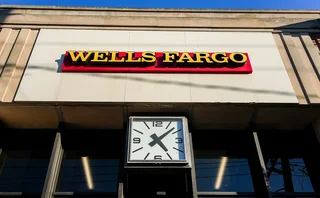Morgan Stanley, JP Morgan lead Risk’s first Dealer Rankings
Dealer Rankings 2023: Analysis of more than 1,000 cuts of Counterparty Radar data offers rare glimpse of sell-side pecking order

Morgan Stanley and JP Morgan lead the pack in the inaugural edition of Risk.net’s Dealer Rankings, a new quantitative analysis of the top derivatives counterparties for US life insurers, mutual funds and exchange-traded funds.
The two leading banks are closely followed by three domestic rivals – Goldman Sachs, Citi and Bank of America. A trio of big Europeans – Barclays, BNP Paribas and Deutsche Bank – provide stiff competition in a range of instruments, according to trade-level data aggregated from regulatory filings.
There is clear water between this group – a ‘big eight’, effectively – and a long tail of other dealers that compete more selectively for US clients.
The analysis is the latest extension of Counterparty Radar, the derivatives data service launched by Risk.net in 2021, which collects, cleans and compiles information on millions of trades executed by US funds and insurers.
Depth by a thousand cuts
Dealers have their own ways of keeping tabs on their relative standing in the over-the-counter market, spending hours each year quizzing their top clients and new hires about how they compare to their bitter rivals, and throwing millions at third-party surveys. The results typically remain private.
Each bank knows how much money it’s making, of course, but this is also a closely guarded secret – bank filings and quarterly earnings calls rarely break out the OTC derivatives businesses, even though they are thought to generate billions of dollars in revenue for the largest dealers. For the most part, questions about the footprint of each dealer and the success of its business are a matter for opinion and anecdote.
That’s what we wanted to change.
The Counterparty Radar data is not perfect, but it is hard data, gleaned from regulatory filings – now covering trades worth $27.4 trillion in notional value. It shows how many insurers each dealer trades with, and how many funds. It shows how many live trades they have with their clients, and how big those trades are.
By slicing this data into more than 1,000 miniature ‘markets’ – we call them cuts – then ranking and awarding points to the sell-side participants in each cut, the Dealer Rankings offers a unique, apples-to-apples view of the relative size and strength of the various banks.
It may prove controversial. While the data is objective, the cuts we chose and the methodology we use are necessarily subjective, and dealers may disagree with those choices.
The full results will be published next week, along with a detailed breakdown of the methodology. In summary, though, each of the 10 OTC instruments covered by the data was broken down into scores of cuts – for specific underlyings, trade sizes and regions, for example. Dealers in each cut were ranked on book size, on number of tickets, and number of clients – as well as in year-on-year changes for each of those metrics.
Points were awarded on the basis of how many banks appear in each cut and then aggregated to generate the final standings for each instrument. The instrument standings were added to create overall tables for each client type – insurers and mutual funds/ETFs – and these two client rankings were then added to produce our overall, combined ranking.
Consistency is rare
Morgan Stanley tops this combined table, but a photo-finish was required to separate it from JP Morgan, a single point behind. Both can point to consistent strength across the two client types and the full set of instruments.
The data covers four asset classes – credit, equity, FX and rates – across nine OTC instruments traded by mutual funds, and seven traded by life insurers. JP Morgan and Morgan Stanley appear in the top 10 for all of these instrument-level rankings. Morgan Stanley takes the top spot in single-name credit default swaps for mutual funds, while also leading for index CDSs and FX forwards for insurers. JP Morgan is top for inflation swaps and FX options with funds, but is less successful with insurers, where it finishes second for swaptions and for single-name CDSs.
Because Counterparty Radar has only one year of data for life insurers, it was not possible to calculate year-on-year changes for each cut – depriving dealers in these markets of a significant number of points. The combined table also subtracts these ‘increase points’ from the mutual fund standings, so there is less of an inbuilt advantage for dealers that perform well with fund clients.
Morgan Stanley gains more of its points from year-on-year growth than JP Morgan so – in the combined table, where increase points are removed from the mutual fund results – the two end up in a virtual dead heat. If increase points had been carried through to the combined table, Morgan Stanley would win more comfortably.
Goldman Sachs is closest to the top duo, primarily thanks to its footprint with funds, where it is a top five dealer in seven of the nine instruments, and number one in swaptions and index CDSs. Perhaps because of its existing size in some of these instruments, the bank gained fewer of its points from year-on-year growth. It was also less strong with insurers than with mutual funds and ETFs.
The opposite is true for Citi and Bank of America, which perform better with insurers – Citi is top dog for single-name CDSs, and BofA for interest rate swaps and swaptions.
Like the top two, BofA appears in the top 10 for all instruments across both client types. Citi misses out on the top 10 for FX forwards with mutual funds – perhaps a consequence of new counterparty risk capital rules that are said to have prompted the bank to rein in what was a market-leading business – but appears in all other instruments.
Barclays is the main non-US threat to the leading dealers, finishing in the top 10 for all instruments with mutual funds – and in the top five for six of those instruments. It also bags three top three placings with insurers.
BNP Paribas takes top spot for repo with mutual funds but misses out on the top 10 in two instruments – inflation swaps and FX options. It is more consistently competitive with insurers, where it finishes in the top 10 across all instruments, including a second place for inflation swaps.
Deutsche is a top-tier rates dealer for insurers – first for inflation swaps, second for interest rate swaps, and fourth for swaptions – but is almost invisible in credit and FX. Among mutual funds, the bank picks up six top 10 finishes.
Below this threshold, competition is patchier. HSBC manages an impressive first-place finish in mutual fund FX forwards trading, driven primarily by year-on-year growth. In all other instruments, though, it fails to place higher than fifth. UBS is competitive in some mutual fund instruments – notably FX forwards – but is largely absent from the insurer rankings.
Overall, American dealers are most dominant in rates – with the exception of repo – and credit trading. When it comes to equity, FX and repo, Europeans offer serious competition. European dealers also appear particularly strong in inflation swaps for life insurers, with Deutsche Bank in first place, BNP Paribas in second and Credit Suisse fourth.
Of course, deeper dives into the various cuts of the data present a more complex picture than the headline figures allow. There, smaller banks prove capable of building niches for themselves – even if they are not competing across the full breadth of the client base and instrument set. This may be based on specific client relationships, or expertise in certain underlyings.
As examples, CIBC is the fourth-ranked dealer in FX forwards with insurers, powered by its prominence in total notional and client numbers, primarily in G10 currencies. The Canadian bank also performs well in longer-dated forwards – trades with a remaining maturity of more than 12 months.
Elsewhere, Crédit Agricole is seventh in the insurer ranking for swaptions, and second among European dealers for book size and number of tickets. Standard Chartered is the sixth-placed dealer for FX options with mutual funds, after outperforming many other dealers in the growth of its business in terms of notional, tickets and number of clients. And Nomura is sixth for both swaptions and repo with mutual funds. Swaptions notional and tickets jumped for the Japanese dealer in 2022, while its repo strength was broad-based, with the bank performing well across multiple collateral types, trade sizes and maturities.
More of this detail – plus the rankings methodology – will be shared in next week’s fuller coverage.
Correction, June 29, 2023: An earlier version of this article had Morgan Stanley and JP Morgan tied for top place at the combined Dealer Rankings. A subsequent review of the data revealed a calculation error. After correcting for the error, Morgan Stanley takes the first place – a single point ahead of JP Morgan. The charts in the article have also been updated to reflect the change. Separately, a statement was corrected to reflect that HSBC’s second-best finish was a fifth place, not an eighth spot as originally asserted.
Questions or comments?
The Dealers Rankings are new for us – and new for the market. We’re looking for feedback. Please contact: michael.paterakis@infopro-digital.com
Only users who have a paid subscription or are part of a corporate subscription are able to print or copy content.
To access these options, along with all other subscription benefits, please contact info@risk.net or view our subscription options here: http://subscriptions.risk.net/subscribe
You are currently unable to print this content. Please contact info@risk.net to find out more.
You are currently unable to copy this content. Please contact info@risk.net to find out more.
Copyright Infopro Digital Limited. All rights reserved.
As outlined in our terms and conditions, https://www.infopro-digital.com/terms-and-conditions/subscriptions/ (point 2.4), printing is limited to a single copy.
If you would like to purchase additional rights please email info@risk.net
Copyright Infopro Digital Limited. All rights reserved.
You may share this content using our article tools. As outlined in our terms and conditions, https://www.infopro-digital.com/terms-and-conditions/subscriptions/ (clause 2.4), an Authorised User may only make one copy of the materials for their own personal use. You must also comply with the restrictions in clause 2.5.
If you would like to purchase additional rights please email info@risk.net
More on Markets
What drove the Taiwan dollar surge?
Foreign speculators, carry unwinds and central bank inaction fuelled the 10% move, not just life insurers, say traders
Novel risk-off CTA strategy passes tariff test
Ai for Alpha’s defensive approach to trend following worked as planned in April turmoil
European investors ramp up FX hedging as ‘dollar smile’ fades
Analysts at one bank expect average hedge ratios to jump from 39% to 70% within six months
CLO market shakes off ETF outflows
Despite record redemptions, exchange mechanics and relatively small volumes cushioned impact
Pension funds hesitate over BoE’s buy-side repo facility
Reduced leveraged and documentation ‘faff’ curb appetite for central bank’s gilt liquidity lifeline
Wells Fargo’s FX strategy wins over buy-side clients
Counterparty Radar: Life insurers looked west for liquidity after November’s US presidential election
How BrokerTec, MarketAxess fared during Treasury rout
Electronic bond trading platforms see spike in volumes and small growth in market share, Risk.net analysis shows
Tariff volatility pushes banks to tighten close-outs
Lawyers say dealers are looking to update playbooks for terminating derivatives trades








